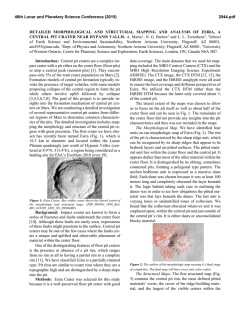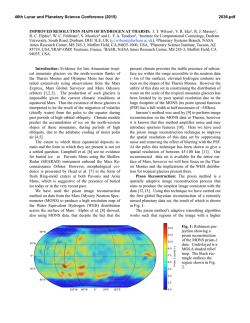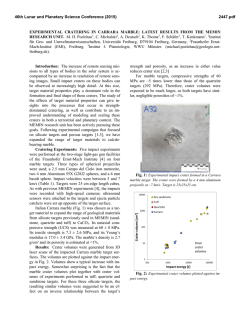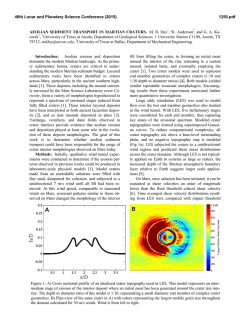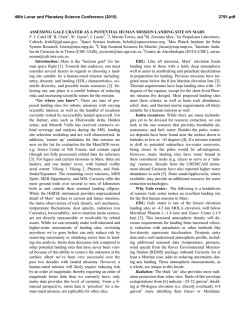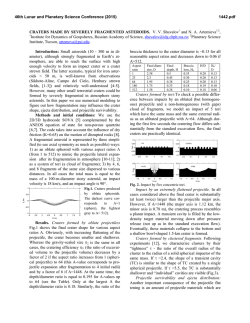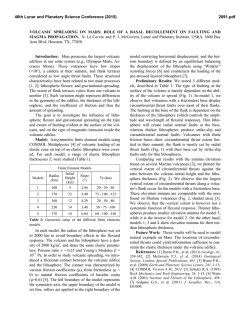
1283
46th Lunar and Planetary Science Conference (2015) 1283.pdf PIT CRATER CHAINS IN THE NYX MONS REGION, VENUS W.C Sawford1, R.E. Ernst1,2, C. Samson1, S.C. Davey1 1Department of Earth Sciences, Carleton University, Ottawa, ON, Canada (LiamSawford@ cmail.carleton.ca), 2Ernst Geosciences, Ottawa, ON, Canada. Introduction: A 160,000 km2 area in the vicinity of Nyx Mons (28-32°N, 47-51°E; Fig. 1) within the Bell Regio region on Venus was mapped, focusing on pit crater chains and their relation with an associated graben-fissure system. Pit craters are bowl-shaped steep-sided circular to elliptical features found on Venus and other celestial bodies in our solar system (Earth, the Moon, Phobos, Eros, Gaspra, Ida and Europa) [1-7]. Their diameter range from 75 m to a few kilometers. Pit craters can be found isolated from others or in long chains that can extend from a few kilometers up to thousands of kilometers. Along a chain, pits can be irregularly spaced, contiguous, or coalescing, where the pits, following collapse, will form a trough. Both magmatic (linked with an underlying dyke) and tectonic origins have been proposed. On Venus, pit crater chains can be found heterogeneously distributed within a graben‐fissure system. When observed, the clustering of pit chains is attributed to variations in lithologies and their physical properties (e.g., the presence of an incompetent layer) [6]. Further work herein on a pit chain cluster associated with Nyx Mons provides additional data toward resolving the timing of Venusian pit chains development: either coincident with or at an unknown time following the formation of a graben by lateral dyke injection, or associated with subsequent reactivation of buried extensional faults. Nyx Mons, Bell Regio Quadrangle: Within the highlands of Bell Regio, there are major tectonomagmatic centers: Tepev Mons, Nefertiti corona, Nyx Mons, as well as two small, steep edifices on the southeast flank of Tepev, the shield volcano Api Mons and several corona with associated flow fields [8, 9]. Nyx Mons, the focus of this study, hosts a radiating graben-fissure system and subparallel pit chains; and circumferential fractures surround the edifice to the east, south and northwest [8-10]. Results: A total of 143 pit chains were mapped; three types have been recognized. The first type includes pits with uniform size and shape (Fig. 2A) and are called “even-sized-type chains”. The second type exhibits at least one trough feature somewhere throughout the chain (Fig. 2B); these chains are referred to as “trough-type chains”. The third type is designated a “tadpole‐type chain”. The “tail” consists of small circular pits while the “head” (ranging in size from 2-10 km) consists of a large, angular pit at the end of the chain (Fig. 2C). Pit crater chains within the study area have an average of 10.9 pits per chain and an average length of 9.3 km. Even-sized chains are the most frequent in the area, followed by trough‐type chains, and tadpole‐type chains. Discussion Link with radiating graben-fissure systems. The pit crater chains are spatially associated, and subparallel, with the graben-fissure systems associated with Nyx Mons. Here, radiating systems broadly focus to the south, but do not define a single convergent point. This radiating pattern suggests that extension required for pit chain formation is provided by a dyke swarm (generally inferred to underly graben-fissure systems on Venus; e.g., [11]). Some pit chains have been inundated by younger lava flows (Fig. 2D), while others are superimposed on the flooding. Two generations of pit chains are inferred from this relationship: a primary generation formed during or after the formation of graben and a secondary generation forming after the volcanic flooding event. Timing of pit crater formation. A central question is whether the pits chains are forming coeval with dyke injection or subsequently. In the former scenario, it is hypothesized that variations along strike in the size, shape and type of pits could correlate with the real-time dynamics of dyke propagation (variations in magma pressure, host rock resistance, depth to top of the dyke, etc.). The presence of tadpole-type chains suggests sequential formation (tail to head or head to tail), and a consistent polarity would be supportive of a link with lateral dyke emplacement. In the NE part of the radiating system, the tadpole head is more frequently located at the NE end of a ‘tail’ (in the direction away from the radiating system center). However, elsewhere in Nyx Mons the ‘tadpole type’ chains have more mixed polarity. The west flank of Nyx Mons hosts grabenfissures that are partially or completely obscured by flooding event(s) along which pit chains have since formed. To explain the occurrence of pit chains here, it is suggested that the flooded graben have been reactived allowing collapse in the overlying volcanic unit. This is an important observation because it indicates that radiating graben-fissure systems continue to deform the subsurface following initial emplacement and that pit chain formation is not limited to the time of initial dyke injection. 46th Lunar and Planetary Science Conference (2015) 1283.pdf Figure 1: Nyx Mons region (centered around 49° E, 30° N). (Left) SAR image. (Right) Black lines: pit crater chains. Grey lines: graben-fissure systems. Grey areas: volcanic flooding. White areas: radar-bright plains material representing an older generation of volcanic flooding. A, B, C, and D indicate locations of frames in Figure 2. Figure 2: Types of pit crater chains observed in study area: (A) even-sized type, (B) trough type, (C) tadpole type. (D) Local volcanic flooding of a pit crater chain. References: [1] Head, J.W. and Coffin, M.F. (1997) In: AGU Geophys. Mon. 100. [2] Bleamaster, L.F. and Hansen, V.L. (2001) LPSC XXXII, Abstract #1316. [3] Montesi, L.G.J. (2001), Geol. S. Am. Spec. Pap. 352, 165-181. [4] Wyrick, D.Y. et al. (2004) JGR, 109(E6), E06005–E06024. [5] Wyrick, D.Y. et al. (2010) LPSC XL, Abstract #1413. [6] Davey S.C. et al. (2013) Can. J. Earth Sci., 50, 109-126. [7] Hoogenboom, T. (2014) Pit crater chain, pit chain. In: Hargitai, H. and Kereszturi, A. (Eds.) Encyclopedia of Planetary Landforms, Springer. [8] Campbell, B.A. and Rogers, P.G. (1994) JGR, 99(E10), 21153. [9] Campbell, B.A. and Campbell, P.G. (2002) U.S. Geological Survey Map I-2743. [10] Rogers, P.G. and Zuber, M.T. (1998) JGR, 103, E7, 16841-16853 [11] Ernst, R.E. et al. (2001) Ann. Rev. Earth. Planet. Sci., 29: 489.
© Copyright 2024

